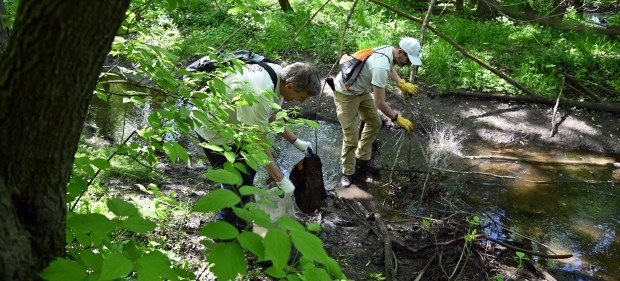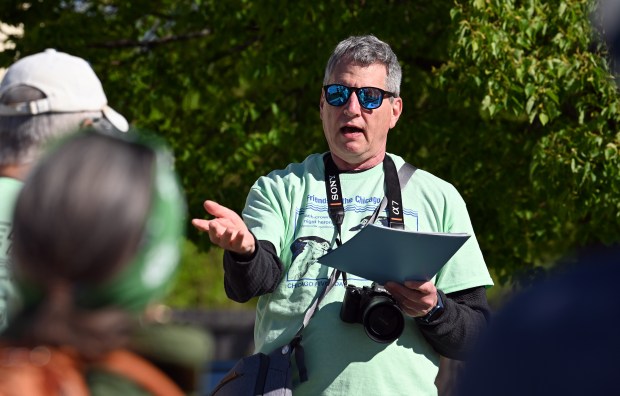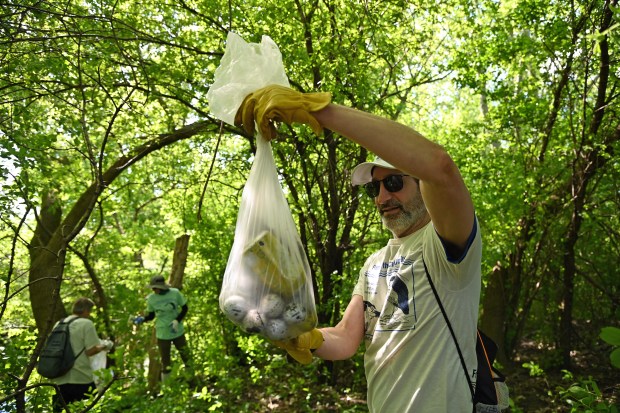The 32nd Annual Chicago River Day cleanup on Saturday included Lake County.
The Friends of the Chicago River have been organizing the regional cleanup since 1992. The Skokie River Nature Preserve in Lake Forest and The Preserve of Highland Park were among eight Chicago River Day venues in Lake County.
The headwaters of the Chicago River start in Lake County, with the most northern fork of the river starting in Park City.
Liz Ricketts, natural areas manager for the Park District of Highland Park, escorted The Preserve of Highland Park volunteers to workday sites about a 10-minute walk from the Park Avenue West parking lot, where volunteers met up Saturday morning.
“We see a lot of single-use plastic,” Ricketts said. “On the west side of the river here is Target, and just beyond that is (Route) 41, so there’s definitely a lot of trash that’s blowing off of our roadways and probably from people that intended to put trash in containers, but they blow out of containers.
“But it’s still there, and it’s in our system and it never goes away,” she said. “It just goes somewhere else. We want to maintain what’s on our property so it doesn’t become someone else’s problem.
“The longer that plastic or trash has been in the system and in the elements, it starts to break down into smaller pieces and then that gets consumed by wildlife,” Ricketts said, “so that’s problematic.
“There’s often plastic in birds’ nests, and they just take it as another material,” she said. “They don’t realize that it’s unnatural.”
Brian Frankl of Highland Park, who volunteered at The Preserve of Highland Park spoke of being, “worried about (birds) swallowing (plastic) and dying, basically. This trash is dangerous for them.”
Frankl’s fellow volunteers found numerous errant golf balls in a lower wetlands ravine along a raised putting green. Golf balls are made of synthetic materials.
Volunteer Brian Loshbough of Highland Park carried a plastic painter’s bucket to collect refuse.
“It’s irritating to pick up everybody else’s trash, but it’s my neighborhood,” he said.

Earlier this month during another cleanup shift, Loshbaugh filled a similar bucket with 250 golf balls. He washed the balls off and gave them to a friend to repurpose for golf practice.
“He’ll probably go to a driving range and they’ll get reused again,” Loshbaugh said of the golf balls.
Soon after the cleanup effort began, volunteers’ trash bags were filled with beverage cans and more golf balls. There was even a Target shopping cart in the middle of a wooded area that was pushed back to the department store.

Volunteer and site captain Steve Greenberg of Highland Park said, “I’ve seen all kinds of things. I saw a couch on the edge of the river. People were hanging out. I don’t know how it got there, (but) we removed it.
“Lawn chairs, tires, we keep cleaning it up,” he said. “This water drains into the Chicago River. This is actually the east fork of the north branch of the Chicago River, but it’s known as the Skokie River.
“It’s important for people to know that this goes into the Chicago River and, because of the reversal of the Chicago River, then goes to the Des Plaines River, and then the Illinois River, and then the Mississippi, so garbage should not be in there because it ultimately could go to the Gulf of Mexico and the ocean,” Greenberg said.

Volunteer Melanie O’Brien of Rogers Park said, “I think these events are important for kind of giving everybody some community solidarity with these natural areas.”
Rachel German of Highland Park said she volunteered, “to give back to our community and keep our beautiful areas beautiful for sure.”
Todd Kuhse and Sandy Oh of Highland Park volunteered for the second consecutive year with their daughter Hazel, 10.
Last year, Oh said, “She (Hazel) saw real-time impact of us being able to clean up garbage, and what happens when you litter, and what people need to do to fix it.”
Kuhse added, “I think she’ll (Hazel) learn and see the visibility of all the garbage, that plastic never goes anywhere, basically. It’s going to be here forever.”

Greenberg said he wished more people would participate in regular cleanup days.
“It seems like we always have the same committed people year after year, and a lot of other people are not interested in these kind of close-to-home improvements to their own community,” he said. “People need to get out more and do that.
“It’s a really enriching experience to know that you’ve made a difference,” Greenberg said.



